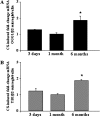Cigarette smoke induces nucleic-acid oxidation in lung fibroblasts
- PMID: 20008282
- PMCID: PMC2970854
- DOI: 10.1165/rcmb.2009-0221OC
Cigarette smoke induces nucleic-acid oxidation in lung fibroblasts
Abstract
Oxidative stress is widely proposed as a pathogenic mechanism for chronic obstructive pulmonary disease (COPD), but the molecular pathway connecting oxidative damage to tissue destruction remains to be fully defined. We suggest that reactive oxygen species (ROS) oxidatively damage nucleic acids, and this effect requires multiple repair mechanisms, particularly base excision pathway components 8-oxoguanine-DNA glycosylase (OGG1), endonuclease III homologue 1 (NTH1), and single-strand-selective monofunctional uracil-DNA glycosylase 1 (SMUG1), as well as the nucleic acid-binding protein, Y-box binding protein 1 (YB1). This study was therefore designed to define the levels of nucleic-acid oxidation and expression of genes involved in the repair of COPD and in corresponding models of this disease. We found significant oxidation of nucleic acids localized to alveolar lung fibroblasts, increased levels of OGG1 mRNA expression, and decreased concentrations of NTH1, SMUG1, and YB1 mRNA in lung samples from subjects with very severe COPD compared with little or no COPD. Mice exposed to cigarette smoke exhibited a time-dependent accumulation of nucleic-acid oxidation in alveolar fibroblasts, which was associated with an increase in OGG1 and YB1 mRNA concentrations. Similarly, human lung fibroblasts exposed to cigarette smoke extract exhibited ROS-dependent nucleic-acid oxidation. The short interfering RNA (siRNA)-dependent knockdown of OGG1 and YB1 expression increased nucleic-acid oxidation at the basal state and after exposure to cigarette smoke. Together, our results demonstrate ROS-dependent, cigarette smoke-induced nucleic-acid oxidation in alveolar fibroblasts, which may play a role in the pathogenesis of emphysema.
Figures






References
-
- Rahman I, Adcock IM. Oxidative stress and redox regulation of lung inflammation in COPD. Eur Respir J 2006;28:219–242. - PubMed
-
- MacNee W. Oxidants and COPD. Curr Drug Targets Inflamm Allergy 2005;4:627–641. - PubMed
-
- Wright JL, Churg A. Current concepts in mechanisms of emphysema. Toxicol Pathol 2007;35:111–115. - PubMed
Publication types
MeSH terms
Substances
Grants and funding
LinkOut - more resources
Full Text Sources
Molecular Biology Databases
Research Materials

